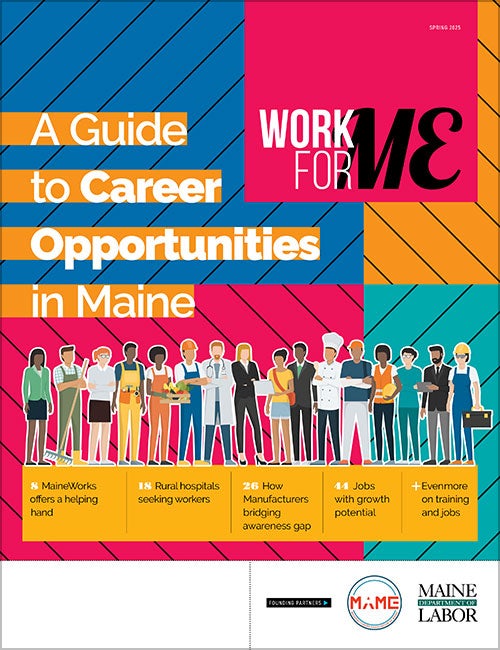
Processing Your Payment
Please do not leave this page until complete. This can take a few moments.
- News
-
Editions
View Digital Editions
Biweekly Issues
- December 1, 2025
- Nov. 17, 2025
- November 03, 2025
- October 20, 2025
- October 6, 2025
- September 22, 2025
- + More
Special Editions
- Lists
- Viewpoints
-
Our Events
Event Info
Award Honorees
- Calendar
- Biz Marketplace
Franklin Printing ‘scrolls’ with the times as industry evolves
 Photo / Fred Field
Franklin Printing in Farmington has a family succession plan. Pictured from left are: President Greg Nemi, production manager Michael Nemi, GM David Nemi and sales manager Jennifer Johnson. They said that the HP web press machine behind them is the most advanced of its type in Maine.
Photo / Fred Field
Franklin Printing in Farmington has a family succession plan. Pictured from left are: President Greg Nemi, production manager Michael Nemi, GM David Nemi and sales manager Jennifer Johnson. They said that the HP web press machine behind them is the most advanced of its type in Maine.
Although Franklin Printing started in the late 1960s as a newspaper publisher, it was the ability to diversify and adopt evolving technologies that allowed the Farmington company to thrive.
As the third generation prepares for ownership, “We set the stage for what we currently think is the right thing to be doing, going forward,” says David Nemi, the company’s general manager and grandson of the founder.
There are advantages for a family-owned business as its role evolves with the times. That includes its ability to consider how decisions affect the entire company.
“We tend to evaluate things from multiple angles, and it’s not always about the dollars,” says Nemi.
Industry decline
Printing in the U.S. is a $76.8 billion industry, according to a market research report by ibisworld.com.
That represents “a considerable and steady decline as digital products and services continue to displace printed materials,” the report says.
Printing technology has advanced, but “demand for traditional print has plummeted, leaving printers with excess capacity and intensifying price pressures.” The decline is projected to continue over the next five years as digitization threatens industry growth.
Adapting to change
The development of new revenue streams and adoption of automated processes are considered critical to adapting to changing dynamics, says a market report by smithers.com.
That’s long been the outlook at Franklin Printing, where diversification and investment into technology have been part of the vision almost from the start.
In the late 1960s, Joseph C. Nemi, a publishing veteran, acquired two newspapers — the Livermore Falls Advertiser and the Franklin Journal — and founded Nemi Publishing Inc.
Initially printed in separate locations, he consolidated operations in 1971, establishing a modest facility. He pioneered the use of offset printing in Maine, according to the company, and diversified into commercial printing.

In 1986, he sold the newspaper division and the company concentrated on commercial printing.
Over the years, continuous investment in technology fueled the company’s growth. Most recently, that’s included pivotal moves into digital printing in 2008 and folding cartons in 2018.
No-brainer
Joe’s sons, Greg and Dick, started as teenagers in the 1970s. Greg recalls going with his father to cover local events for the newspapers.
“My first job was to help him in the darkroom developing film,” he says.
He pretty much knew he wanted to go into the family business and started full-time in 1976, working in production. Dick, who served as vice president and was with the company for 44 years, recently retired.
The third generation also started as teenagers, working summers. Dick’s son Mike recalls his father advising him to explore other career possibilities before deciding on the family business. So he pursued firefighting for a while, then got a degree in aviation management. But he always wanted to return.
“I started here in 2011,” Mike says. “I listened to my father — I tried different things, which brought another perspective. You work as a team, especially in production, which is something I took from firefighting.”
Greg’s daughter Jennifer worked for a decade after college at family-owned construction firms in Massachusetts and Vermont. She returned in 2015 to work for her family’s firm.
“I learned a lot by working for family businesses,” she says. “I thought, ‘Why am I working for another family when could be working for my own family?’ And I wanted to be back in Maine closer to family, so it was a no-brainer. I had worked in the business in high school and college, so I understood the dynamics of working in production and finishing and doing a little bit of office work.”
Long-time employees
Greg’s son David, the oldest of the third generation, graduated in 2003 from Babson College, a Massachusetts school with an entrepreneurship focus.
“I always had a passion for the business world, probably because I was growing up around it, seeing my father and my grandfather doing what they had done up to that point,” David says. “I knew I wanted to be in that environment.”

David went into the family business thinking maybe he’d stay a few years.
“But as I got involved as a member of the family, I was given more responsibility,” he says. “At the same time, my grandfather, who was still working at the time, became ill. So I felt I was needed to help with operation of the company. I think that experience made me realize I could have an impact on the business. And here I am, 22 years later.”
Today, Greg is sole owner and president. David is general manager, Jennifer oversees the sales team and Mike leads printing and bindery production. The company has 46 employees, some with tenures of 20 years and even 40 years or more. The number has been stable over the past few years, but down from the mid- to high-50s in the early 2000s due to the adoption of automated machinery.
“A lot I’ve known since I was in school,” says Greg, referring to employees. “Always employed lots of local people in the area.”
Different point of view
As an employer, the family-owned dynamic has advantages over corporate ownership, the Nemis agree.
“Family-run businesses tend to make emotional decisions about what they’re doing, which I think is helpful to employees,” says David. “Larger corporations, especially public corporations, ultimately look at the bottom line.”

Health insurance is one example of how that works.
“We’ve historically helped families with cost-sharing, especially now as it continues to become more expensive,” says David.
Packaging segment
The future of the print industry might be uncertain, but the Nemis consider the addition of folding carton production to be a sustainable segment that they expect to grow.
Not counting a spike during the pandemic related to print materials for COVID testing products, revenue is on an upward trajectory by 30% to 40% compared with pre-pandemic numbers.
Growth is primarily driven by the production of folding cartons. Established in 2018, the company’s packaging segment is relatively new. Customers are primarily food and beverage retailers and the human and animal medical industry, primarily in the Northeast, with some customers across the U.S.
Production takes place at the company’s 37,500-square-foot facility in Farmington. In 2021 and 2022, investment into new equipment, including die cutting and gluing machines for folding cartons, was about $3.5 million. Other new machines include ink jet web printing technology.
Additional investments are under consideration, such as equipment updates for efficient mailing and fulfillment services for companies that provide customer communications.
Sustainability investments include a contract with an outside program, Green-E Energy, that sells the company verified clean energy for all of its operations. Other sustainability actions include recycling, certain technologies and materials to minimize waste or cut emissions and Forest Stewardship Council certification to ensure paper is sourced from responsibly managed forests.
Succession plan
The investments are part of the strategy leading up to a transition of ownership. The family recently finalized a succession plan that will allow Greg to hand over the company to the third generation. The plan calls for David, Michael and Jennifer to take over on or before Dec. 31, 2030.
The investments in packaging and ink jet technology in recent years were to prepare the company for the future, notes Greg.
Succession planning began last winter through a consultant and included splitting ownership, currently two-way, into three stakes.
The toughest thing Greg had to do was come up with a retirement date, not something he was eager to do. But having a date is important both for the successors and for employees, the Nemis say.
“It’s important for our employees to know we exist today and we have a plan to exist well into the future,” says David.
Mainebiz web partners
Related Content

The Giving Guide
The Giving Guide helps nonprofits have the opportunity to showcase and differentiate their organizations so that businesses better understand how they can contribute to a nonprofit’s mission and work.
Learn More
Work for ME
Work for ME is a workforce development tool to help Maine’s employers target Maine’s emerging workforce. Work for ME highlights each industry, its impact on Maine’s economy, the jobs available to entry-level workers, the training and education needed to get a career started.
Learn More
Groundbreaking Maine
Whether you’re a developer, financer, architect, or industry enthusiast, Groundbreaking Maine is crafted to be your go-to source for valuable insights in Maine’s real estate and construction community.
Learn more-
The Giving Guide
The Giving Guide helps nonprofits have the opportunity to showcase and differentiate their organizations so that businesses better understand how they can contribute to a nonprofit’s mission and work.
-
Work for ME
Work for ME is a workforce development tool to help Maine’s employers target Maine’s emerging workforce. Work for ME highlights each industry, its impact on Maine’s economy, the jobs available to entry-level workers, the training and education needed to get a career started.
-
Groundbreaking Maine
Whether you’re a developer, financer, architect, or industry enthusiast, Groundbreaking Maine is crafted to be your go-to source for valuable insights in Maine’s real estate and construction community.
ABOUT
NEW ENGLAND BUSINESS MEDIA SITES
No articles left
Get access now
In order to use this feature, we need some information from you. You can also login or register for a free account.
By clicking submit you are agreeing to our cookie usage and Privacy Policy
Already have an account? Login
Already have an account? Login
Want to create an account? Register
Get access now
In order to use this feature, we need some information from you. You can also login or register for a free account.
By clicking submit you are agreeing to our cookie usage and Privacy Policy
Already have an account? Login
Already have an account? Login
Want to create an account? Register








0 Comments